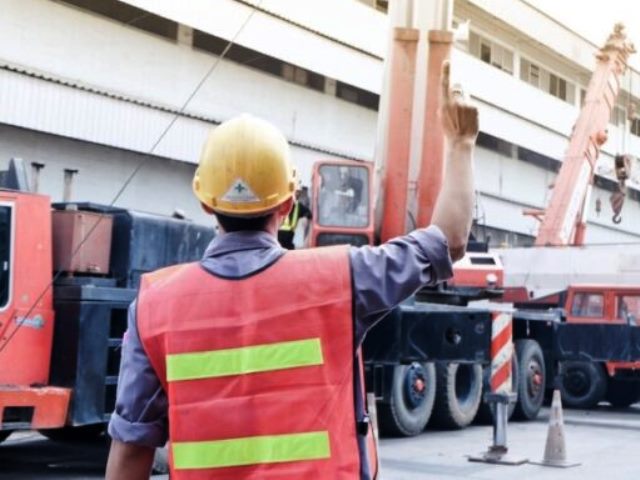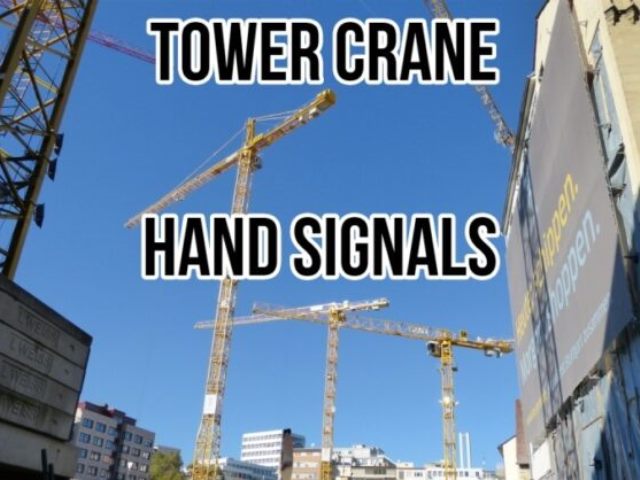Here is a crane hand signal chart, which provides the standardized hand signals used in crane operations to ensure clear communication between the crane operator and the signal person:
| Signal | Description |
|---|---|
| Hoist | Forearm vertical, forefinger pointing up, move hand in small horizontal circles. |
| Lower | Forearm vertical, forefinger pointing down, move hand in small horizontal circles. |
| Use Main Hoist | Tap fists on head, then use regular signals. |
| Use Whipline | Tap elbow with one hand, then use regular signals. |
| Raise Boom | Arm extended, fingers closed, thumb pointing upward. |
| Lower Boom | Arm extended, fingers closed, thumb pointing downward. |
| Swing | Arm extended, point with finger in direction of swing. |
| Stop | Arm extended, palm down, move arm back and forth horizontally. |
| Emergency Stop | Arm extended, palm down, move arm back and forth horizontally rapidly. |
| Travel (Both Tracks) | Rotate fists around each other in front of the body. |
| Travel (One Track) | Point with one finger in direction of travel. |
These signals are designed to be clear and unambiguous to ensure safe and effective crane operations.
What are the proper hand signals for cranes?
Hand signals used in crane operations are standardized to ensure clear communication between the crane operator and the signal person.
- Hoist
- Lower
- Use Main Hoist
- Use Whipline (Auxiliary Hoist)
- Raise Boom
- Lower Boom
- Swing
- Stop
- Emergency Stop
- Travel
- Travel (One Track)
These signals are internationally recognized and are crucial for maintaining safety and efficiency on construction sites or any environment where cranes are used.
It’s essential for both the signal person and the crane operator to be thoroughly familiar with these signals and to ensure they are clearly understood before beginning operations.
These signals are standardized to ensure safe and effective communication between the signal person and the crane operator during operations.
Questions about Crane Hand Signal Chart
These FAQs provide a basic understanding of crane hand signal charts and their importance in ensuring safe crane operations. For specific regulations or detailed guidance, refer to local safety standards and crane operation manuals.
Here are some frequently asked questions (FAQs) about crane hand signal charts:
What is a crane hand signal chart used for?
A crane hand signal chart is used to facilitate clear communication between the crane operator and the signal person (or rigger) on the ground. It ensures safe and efficient crane operations by providing standardized gestures that indicate specific actions or commands.
Why are crane hand signals important?
Crane hand signals are crucial for safety on construction sites and other work environments where cranes are used. They provide a reliable means of communication in situations where verbal communication may be difficult or unreliable due to distance, noise, or other factors.
Who typically uses crane hand signals?
Crane operators and signal persons (riggers) primarily use crane hand signals. The signal person is responsible for directing the crane operator using these signals to perform tasks such as lifting, lowering, swinging, and stopping operations.
Are crane hand signals standardized?
Yes, crane hand signals are standardized to ensure consistency and clarity across different construction sites and countries. Standardization helps to prevent misunderstandings and reduces the risk of accidents due to miscommunication.
Where can I find a crane hand signal chart?
Crane hand signal charts are typically included in crane operation manuals provided by equipment manufacturers. They are also available through safety organizations, regulatory bodies, and online resources related to crane operations and safety.
How should crane operators and signal persons learn and practice hand signals?
Both crane operators and signal persons should undergo training that includes learning and practicing crane hand signals. Training programs often include classroom instruction, practical demonstrations, and hands-on practice to ensure proficiency and safety awareness.
What should I do if I encounter unfamiliar crane hand signals?
If you encounter unfamiliar crane hand signals or are unsure of a signal being used, do not proceed with the operation. Instead, seek clarification from the signal person or supervisor before continuing. Safety should always be the top priority.
Can crane hand signals be supplemented with other forms of communication?
Yes, while crane hand signals are the primary method of communication, they can be supplemented by radio communication, visual aids (such as markings on the ground), or other means to enhance safety and accuracy in crane operations.

Mobile Crane Hand Signals
Standard hand signals for crane operators

Tower Crane Hand Signals
Hand signals in crane operation
